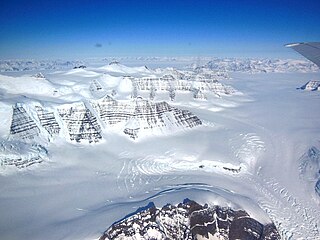
A glacier is a persistent body of dense ice that is constantly moving downhill under its own weight. A glacier forms where the accumulation of snow exceeds its ablation over many years, often centuries. It acquires distinguishing features, such as crevasses and seracs, as it slowly flows and deforms under stresses induced by its weight. As it moves, it abrades rock and debris from its substrate to create landforms such as cirques, moraines, or fjords. Although a glacier may flow into a body of water, it forms only on land and is distinct from the much thinner sea ice and lake ice that form on the surface of bodies of water.

A moulin is a roughly circular, vertical well-like shaft formed where a surface meltstream exploits a weakness in the ice. The term is derived from the French word for mill.

Glacier morphology, or the form a glacier takes, is influenced by temperature, precipitation, topography, and other factors. The goal of glacial morphology is to gain a better understanding of glaciated landscapes and the way they are shaped. Types of glaciers can range from massive ice sheets, such as the Greenland ice sheet, to small cirque glaciers found perched on mountain tops. Glaciers can be grouped into two main categories:

Eric J. Rignot is the Donald Bren, Distinguished and Chancellor Professor of Earth system science at the University of California, Irvine, and a Senior Research Scientist for the Radar Science and Engineering Section at NASA's Jet Propulsion Laboratory. He studies the interaction of the polar ice sheets in Greenland and Antarctica with global climate using a combination of satellite remote sensing, airborne remote sensing, understanding of physical processes controlling glacier flow and ice melt in the ocean, field methods, and climate modeling. He was elected at the National Academy of Sciences in 2018.

Petermann Glacier is a large glacier located in North-West Greenland to the east of Nares Strait. It connects the Greenland ice sheet to the Arctic Ocean at 81°10' north latitude, near Hans Island.

Operation IceBridge (OIB) was a NASA mission to monitor changes in polar ice by utilizing airborne platforms to bridge the observational gap between the ICESat and ICESat-2 satellite missions. The program, which ran from 2009 to 2019, employed various aircraft equipped with advanced instruments to measure ice elevation, thickness, and underlying bedrock topography. The data collected helped scientists understand ice dynamics, contributing to predictive models of ice and sea-level rise. IceBridge played a crucial role in discovering the longest canyon on Earth beneath the Greenland ice sheet.

Bruckner Glacier, is a glacier in eastern Greenland.

The Grand Canyon of Greenland is a tentative canyon of record length discovered underneath the Greenland ice sheet as reported in the journal Science on 30 August 2013, by scientists from the University of Bristol led by Jonathan Bamber, University of Calgary, and University of Urbino, who described it as a mega-canyon.

Sehested Fjord ) is a fjord of the King Frederick VI Coast in the Sermersooq municipality, southeastern Greenland.

The Hutchinson Glacier is a large active glacier on the east coast of the Greenland ice sheet.

Hiawatha Glacier is a glacier in northwest Greenland, with its terminus in Inglefield Land. It was mapped in 1922 by Lauge Koch, who noted that the glacier tongue extended into Lake Alida. Hiawatha Glacier attracted attention in 2018 because of the discovery of a crater beneath the surface of the ice sheet in the area. A publication noted in 1952 that Hiawatha Glacier had been retreating since 1920.

Fimbul Glacier, is a glacier in eastern Greenland.

Heim Glacier, is a glacier in eastern Greenland. It is named after Swiss geologist and glacial phenomena expert Albert Heim (1849–1937).

Skinfaxe is a glacier of the King Frederick VI Coast in the Sermersooq municipality, southeastern Greenland.

Rimfaxe is a glacier of the King Frederick VI Coast in the Sermersooq municipality, southeastern Greenland.

Tjasse is a glacier of the King Frederick VI Coast area in the Sermersooq municipality, southeastern Greenland.

Bernstorff Glacier, is a glacier in the King Frederick VI Coast, Sermersooq, southeastern Greenland.

Dodge Glacier, is a glacier in northwestern Greenland. Administratively it belongs to the Avannaata municipality.

Storebjørn Glacier, is a glacier in the King Frederick VI Coast, Sermersooq, southeastern Greenland.















